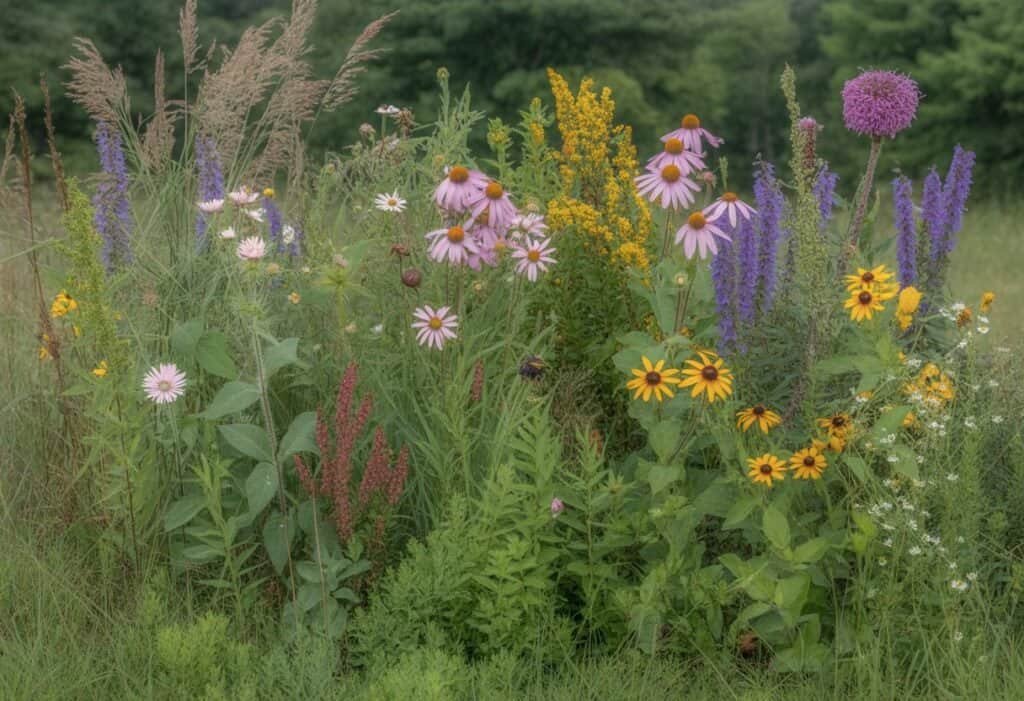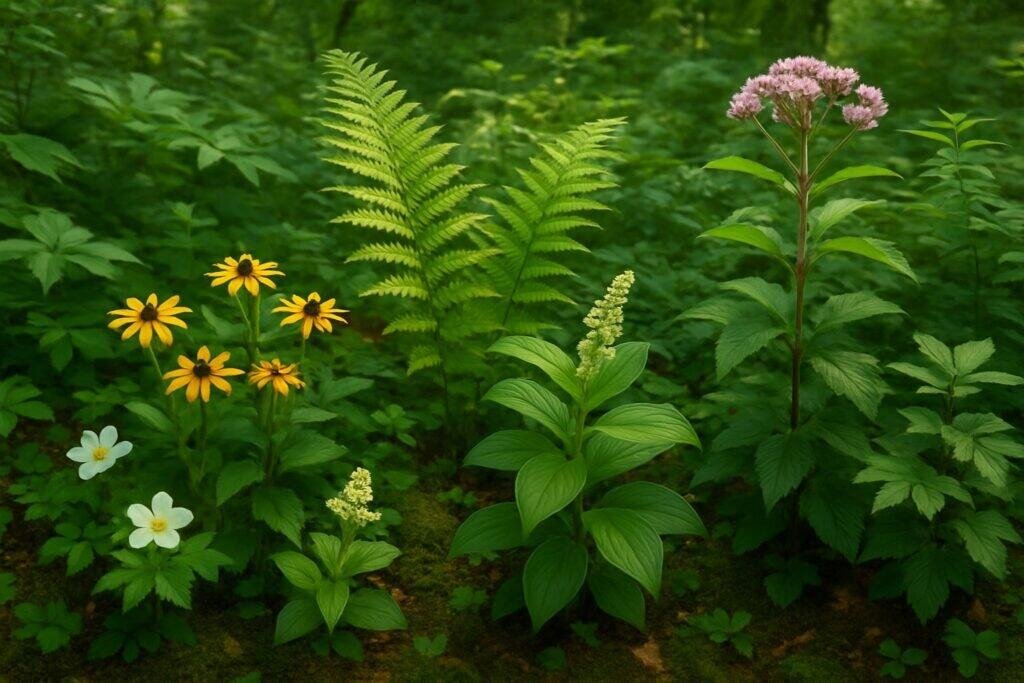Indiana’s native plants have shaped the state’s landscapes for thousands of years, long before European settlers arrived. These plants evolved to thrive in our local soils, rainfall patterns, and temperature ranges.
Growing native plants in your garden supports local ecosystems. They require less maintenance and create habitat for Indiana’s wildlife.
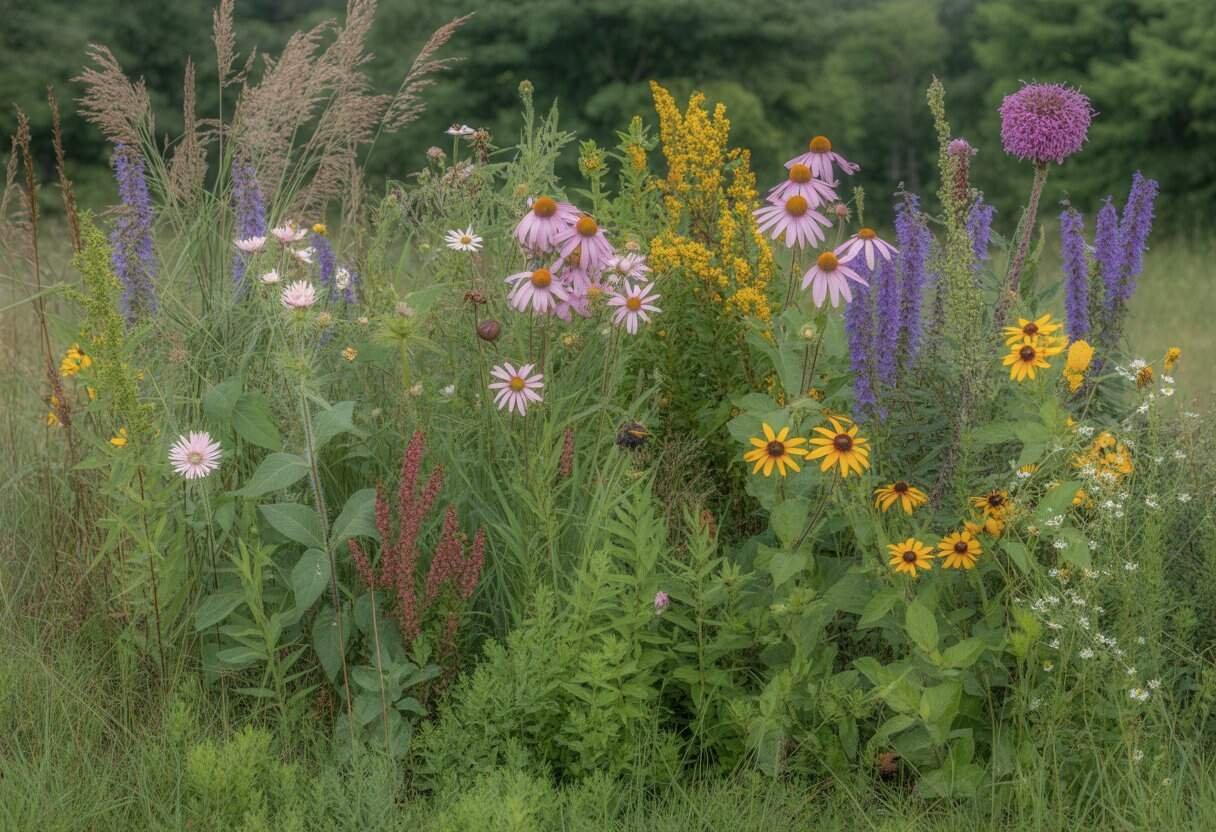
Native plants come in stunning varieties, from the vibrant purple coneflower to the majestic oak tree. Their deep root systems help prevent erosion and filter water.
Unlike exotic species, native plants don’t become invasive or disrupt natural habitats. You don’t need a large space to grow Indiana natives.
Even small gardens or container plantings can include native species that provide food and shelter for birds, butterflies, and bees. These plants connect your home to Indiana’s natural heritage and bring its beauty right to your doorstep.
Key Takeaways
- Native plants require less water, fertilizer, and maintenance than non-native species while supporting local wildlife.
- Indiana offers diverse native plants for every garden situation, from sunny prairie flowers to shade-loving woodland species.
- Planting natives helps preserve Indiana’s botanical heritage and creates ecological corridors for pollinators and birds.
Understanding Indiana Native Plants
Indiana’s landscape features a diverse array of native plants that evolved over thousands of years to thrive in the state’s unique soil and climate. These plants support local wildlife, preserve soil health, and maintain the natural heritage of the Hoosier state.
Definition and Characteristics
Native plants in Indiana are species that occurred naturally in the region before European settlement. These plants evolved in Indiana’s specific climate and soil conditions over thousands of years.
Native Indiana plants include trees like the tulip poplar and white oak. Shrubs such as buttonbush and spicebush, and wildflowers like purple coneflower and cardinal flower also belong to this group.
These plants typically require less maintenance than non-native species. They have developed natural defenses against local pests and diseases.
Indiana native plants adapt well to the state’s seasonal changes. They can withstand cold winters, hot summers, and varying precipitation patterns without special care.
Many native plants have deep root systems that help them survive drought conditions. These roots also contribute to soil stability.
Benefits to Local Ecosystems
Native plants provide essential food and shelter for Indiana wildlife. Local insects, birds, and mammals have evolved alongside these plants and depend on them for survival.
Indiana’s native plant species help prevent erosion. Their extensive root systems hold soil in place during heavy rains and floods.
These plants require minimal watering once established. This reduces water consumption and helps maintain natural hydrology patterns.
Native plants thrive in local soils without chemical amendments. They eliminate the need for fertilizers and pesticides.
Indiana’s waterways benefit from native vegetation along their banks. These plants filter pollutants and reduce runoff.
Role in Biodiversity
Native plants form the foundation of Indiana’s food webs. They support over 400 species of native bees and many other beneficial insects.
The decline of native plant populations threatens Indiana’s wildlife. Many animal species cannot adapt to non-native plants as food sources.
Areas rich in native plant species typically support more diverse animal populations. Indiana’s endangered species often depend on specific native plants.
For example, the Mitchell’s satyr butterfly relies on native sedges in wetland habitats. Native plant communities create complex habitats with multiple layers—from groundcover to canopy—supporting diverse wildlife needs.
Preserving patches of native plants creates crucial corridors for wildlife movement across fragmented landscapes in Indiana.
Notable Indiana Native Wildflowers
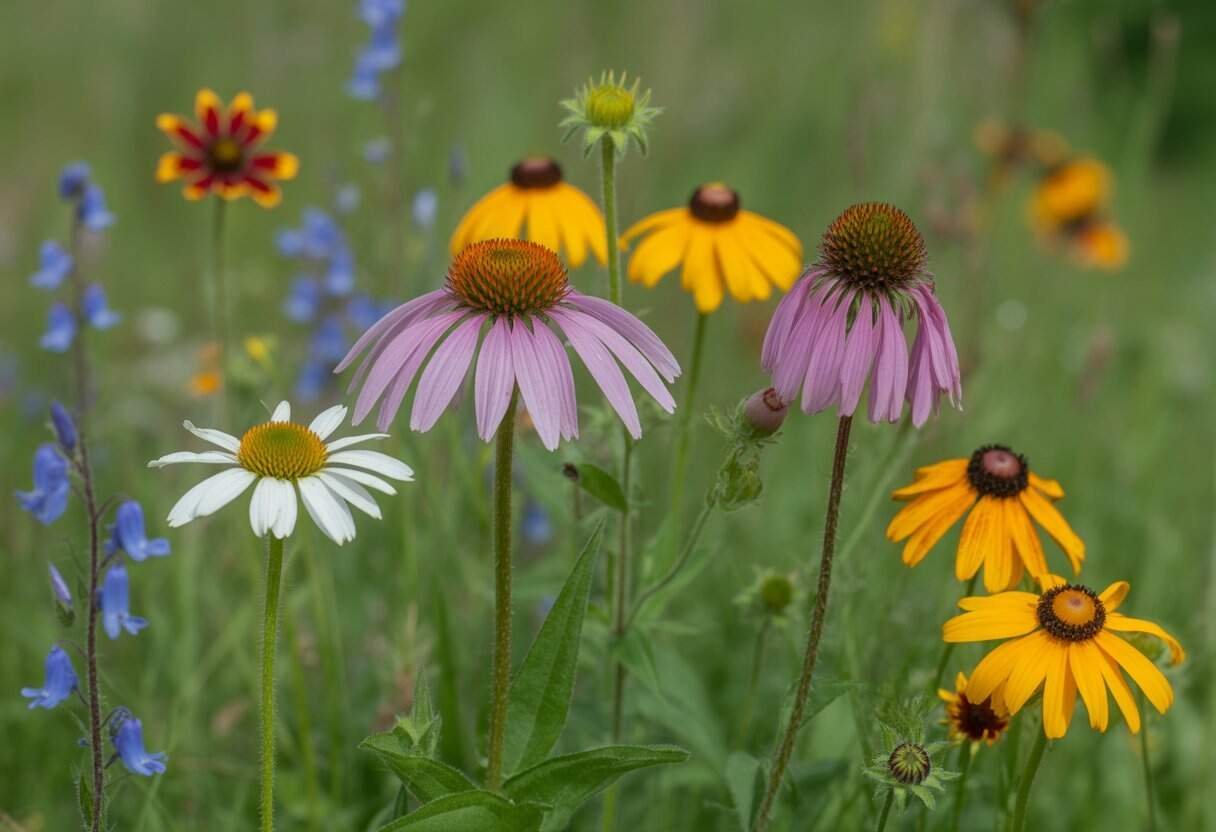
Indiana’s landscape blooms with diverse native wildflowers that add color and ecological value to the state’s natural areas. These wildflowers support local pollinators and reflect Indiana’s rich botanical heritage.
Popular Wildflower Species
Cardinal Flower displays striking red blooms that attract hummingbirds and butterflies. This vibrant perennial grows best in moist areas along streams and ponds.
Jack-in-the-Pulpit features a unique hooded structure with a spadix that resembles a preacher in a pulpit. Its green and purple striped appearance makes it a woodland favorite.
Celandine Poppy brightens forest floors with golden-yellow flowers in early spring. These cheerful blooms thrive in shady, rich soil conditions.
Indian Pink showcases tubular red flowers with yellow throats, creating a dramatic contrast. Despite its name, it belongs to the Logania family, not the pink family.
Shooting Star produces nodding, star-shaped flowers in pink or white. Their swept-back petals resemble comets streaking across the sky.
Wild Quinine bears flat-topped white flower clusters that historically served medicinal purposes. Its drought tolerance makes it valuable for prairie restoration.
Seasonal Bloom Times
Spring Bloomers (March-May):
- Celandine Poppy
- Shooting Star
- Two-flowered Cynthia
These early bloomers take advantage of sunlight before tree canopies fully develop. Spring wildflowers often have shorter blooming periods, creating urgency for pollinators.
Summer Flowers (June-August):
- Cardinal Flower
- American Bellflower
- Indian Pink
Summer wildflowers withstand higher temperatures and typically display more vibrant colors. They provide crucial nectar sources during peak insect activity periods.
Fall Blooming Species (September-October):
- Aromatic Aster
- Showy Goldenrod
- Common Boneset
Fall-blooming plants offer critical late-season resources for migrating butterflies. Aromatic Aster’s purple flowers contrast beautifully with Showy Goldenrod’s bright yellow plumes.
Wildflower Identification Tips
Look at flower structure first when identifying wildflowers. Count petals, observe their arrangement, and note whether flowers appear individually or in clusters.
Leaf characteristics provide important clues. Examine whether leaves are opposite (paired) or alternate (staggered) on stems.
Also note leaf shape, edge patterns (smooth or toothed), and surface texture. Growth habit matters for identification.
False Sunflower grows tall with multiple blooms. Jack-in-the-Pulpit remains low with a single distinctive flower.
Simple Field Guide Features:
- Bloom time
- Habitat preference (woodland, prairie, wetland)
- Height range
- Flower color
- Special features (scent, fuzzy leaves, etc.)
Taking clear photographs from multiple angles helps with later identification. Include images of the entire plant, flowers, and leaf arrangements for most accurate results.
Native Trees and Shrubs of Indiana
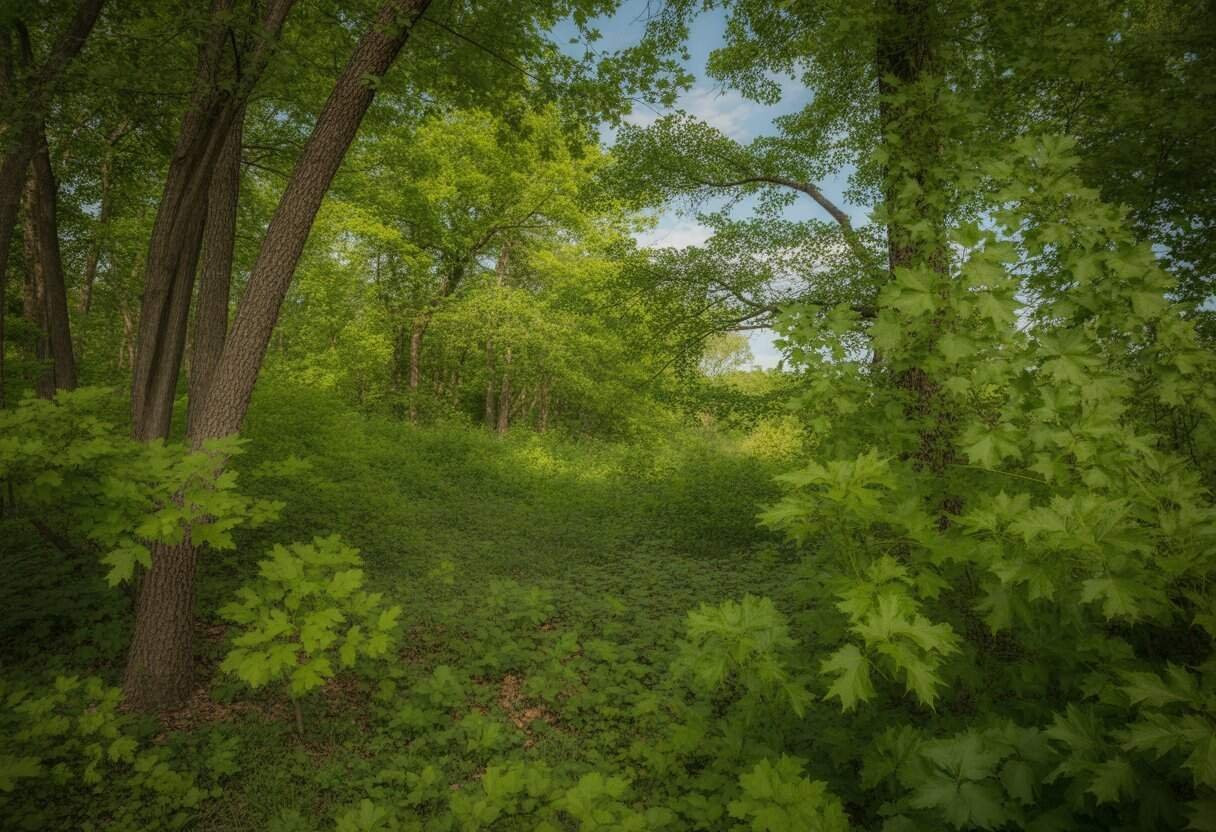
Indiana’s landscape is home to a diverse array of native trees and shrubs that thrive in the state’s climate and soil conditions. These plants provide essential habitat for wildlife and add beauty and ecological value to both natural areas and home landscapes.
Key Native Trees
The tulip tree (Liriodendron tulipifera) stands as Indiana’s state tree, reaching heights of 70-90 feet with distinctive tulip-shaped flowers. This majestic tree features unique four-lobed leaves that turn golden yellow in fall.
Red maple (Acer rubrum) thrives throughout Indiana, offering brilliant red fall color and adaptability to various soil conditions. These fast-growing trees can reach 40-60 feet tall and provide important early-season nectar for pollinators.
The redbud (Cercis canadensis) announces spring with its pink-purple flowers that bloom directly on branches before leaves appear. This smaller native tree typically grows 20-30 feet tall.
Flowering dogwood (Cornus florida) delivers year-round interest with spring white flowers, summer berries for wildlife, and rich burgundy fall color. It performs best as an understory tree in partially shaded conditions.
Important Native Shrubs
Grey dogwood (Cornus racemosa) produces white flower clusters in spring and attractive white berries that birds eagerly consume. This adaptable shrub grows 10-15 feet tall and tolerates various conditions.
Ninebark (Physocarpus opulifolius) earns its name from its exfoliating bark. It offers three-season interest with white flower clusters, colorful seed heads, and excellent drought tolerance once established.
Spicebush (Lindera benzoin) serves as a host plant for spicebush swallowtail butterflies. It produces aromatic foliage that turns golden yellow in fall, with small yellow flowers appearing in early spring before leaves emerge.
Buttonbush (Cephalanthus occidentalis) thrives in wet areas, producing unique spherical white flowers that attract pollinators. Its seeds provide food for waterfowl and other birds.
Black chokeberry (Aronia melanocarpa) offers white spring flowers followed by nutrient-rich dark berries that persist through winter. This adaptable shrub also displays outstanding red fall foliage.
Native Trees for Home Gardens
The redbud makes an excellent focal point in home gardens, with its compact size and spectacular spring bloom. Plant in well-drained soil with morning sun and afternoon shade for best results.
Flowering dogwood creates a stunning understory layer beneath taller trees. These trees prefer partial shade and protection from harsh afternoon sun, especially when young.
For larger properties, the tulip tree provides impressive height and unique flowers. Homeowners should note it requires ample space to develop properly.
Fragrant sumac (Rhus aromatica) works well as a low-maintenance ground cover for slopes or difficult areas. This drought-tolerant shrub grows 2-6 feet tall with attractive red fall color.
American cranberrybush (Viburnum trilobum) and elderberry (Sambucus canadensis) offer both ornamental value and edible berries. The cranberrybush produces bright red fruits that persist through winter, while elderberry’s dark purple berries can be harvested for jams and syrups.
Indiana Native Plants for Pollinators and Wildlife
Native plants in Indiana play a crucial role in supporting local pollinators and wildlife. These plants evolved alongside native insects and animals, creating mutually beneficial relationships that help maintain healthy ecosystems.
Plants That Attract Pollinators
Indiana’s native plants provide essential food and habitat for bees, butterflies, and other pollinators. Prairie blazing star (Liatris spicata) produces tall purple flower spikes that attract many butterfly species, including monarchs and swallowtails.
Butterfly milkweed (Asclepias tuberosa) serves as both a nectar source and the only food monarch caterpillars can eat. Its bright orange flowers bloom from June to August.
Wild bergamot (Monarda fistulosa) draws in bumblebees and hummingbirds with its lavender blooms and fragrant foliage. This plant thrives in various soil conditions across Indiana.
Other pollinator favorites include:
- Purple coneflower (Echinacea purpurea)
- New England aster (Symphyotrichum novae-angliae)
- Wild columbine (Aquilegia canadensis)
Supporting Wildlife Habitat
Native plants provide food, shelter, and nesting sites for Indiana wildlife. Rattlesnake master (Eryngium yuccifolium) offers unique habitat value with its yucca-like leaves and distinctive flower heads that attract beneficial insects.
Oak trees support over 500 species of caterpillars, which become food for birds and other wildlife. A single oak can become a mini-ecosystem in your landscape.
Berry-producing shrubs like elderberry (Sambucus canadensis) and serviceberry (Amelanchier laevis) provide critical food sources for birds throughout the seasons.
Grasses such as little bluestem (Schizachyrium scoparium) offer winter shelter for small mammals and birds. Their seed heads also provide food during scarce winter months.
Adding a water source near native plantings creates a complete wildlife habitat that supports Indiana’s biodiversity year-round.
Incorporating Indiana Native Plants in Home Gardens
Adding Indiana native plants to your yard creates beautiful, low-maintenance spaces that support local wildlife. These plants have adapted to local conditions over thousands of years, making them ideal choices for sustainable home landscapes.
Design Ideas for Native Plant Gardens
Start with a plan that considers your yard’s conditions. Sunny areas suit prairie plants like butterfly milkweed and purple coneflower, while woodland plants such as wild ginger and ferns thrive in shade.
Create layers in your garden by using trees, shrubs, and ground covers. Place taller species like Joe-Pye weed and ironweed at the back, with shorter plants like wild columbine in front.
Group plants with similar water needs together. Prairie dropseed and little bluestem require less water, while cardinal flower prefers moist soil.
Select plants that bloom at different times to provide seasonal interest. Virginia bluebells offer spring color, black-eyed Susans shine in summer, and asters add fall interest.
Maintenance and Care Tips
Water new native plants regularly until they establish, typically for the first growing season. Afterward, most Indiana natives need minimal supplemental watering except during severe drought.
Avoid chemical fertilizers. Indiana native plants thrive in local soil without amendments.
Too much fertilizer can harm these plants and cause excessive growth. Leave seed heads and stems standing through winter to provide food and shelter for birds and beneficial insects.
Cut back dead growth in early spring instead of fall. This protects overwintering insects and adds winter interest to the garden.
Apply a thin layer of leaf mulch annually to suppress weeds and add nutrients. This mimics the natural forest floor that many native plants prefer.
Native Plant Selections for Varying Habitats
Indiana offers diverse habitats that support a wide range of native plants. The right plant selection depends on specific growing conditions like moisture levels, sun exposure, and soil type.
Native Plants for Moist Areas
Moist areas in Indiana suit several beautiful native species. Ostrich fern (Matteuccia struthiopteris) grows up to 5 feet tall with distinctive feathery fronds and creates dramatic vertical interest in wet woodland gardens.
Maidenhair fern (Adiantum pedatum) provides delicate beauty with its fan-shaped fronds and black stems. This species grows 1-2 feet tall and prefers consistently moist, rich soil.
For flowering options, choose Cardinal Flower (Lobelia cardinalis) with its brilliant red blooms that attract hummingbirds. Great Blue Lobelia (Lobelia siphilitica) adds blue-violet flowers in late summer.
Virginia creeper (Parthenocissus quinquefolia) adapts well to moist conditions. This versatile vine features five-pointed leaves that turn vibrant red in fall.
Species for Thickets and Shade
Thickets and shady areas need plants adapted to lower light. Black Cohosh (Actaea racemosa) produces tall white flower spikes that brighten shady spots in summer.
Woodland Phlox (Phlox divaricata) creates carpets of lavender-blue flowers in spring. This low-growing perennial reaches only 8-12 inches tall.
Native shrubs for thickets include:
- Spicebush (Lindera benzoin)
- American Hazelnut (Corylus americana)
- Common Elderberry (Sambucus canadensis)
Virginia creeper also performs well in thickets, climbing trees or spreading as ground cover. Its ability to grow in various light conditions makes it versatile for woodland edges.
Wild Ginger (Asarum canadense) offers attractive heart-shaped leaves and spreads slowly to form groundcover in shaded areas.
Plants for Sunny and Dry Locations
Sunny, dry locations in Indiana support prairie-like conditions perfect for many native species. Little Bluestem (Schizachyrium scoparium) stands out with blue-green summer color and rusty-orange fall hues.
This grass typically grows 2-4 feet tall and provides winter interest. Butterfly Weed (Asclepias tuberosa) thrives in dry soil with bright orange flowers that attract pollinators.
This drought-tolerant perennial reaches 1-3 feet tall. Purple Coneflower (Echinacea purpurea) produces pink-purple daisy-like flowers that bloom for weeks.
It grows 2-5 feet tall and tolerates poor soil conditions. Other excellent choices include:
- Black-Eyed Susan (Rudbeckia hirta)
- Prairie Dropseed (Sporobolus heterolepis)
- Aromatic Aster (Symphyotrichum oblongifolium)
These sun-loving plants need minimal watering once established. They offer low-maintenance options for dry gardens.
Conservation Efforts and Resources
Many organizations and individuals in Indiana work to protect and restore native plant communities. These efforts preserve biodiversity, support wildlife, and create more sustainable landscapes throughout the state.
The Role of INPS
The Indiana Native Plant Society (INPS) leads conservation initiatives throughout the state. Founded in 1993, this organization includes over 1,000 members dedicated to preserving Indiana’s native flora.
INPS hosts educational workshops, field trips, and annual conferences to share knowledge about native plants. Local chapters organize community plantings and invasive species removal events in parks and natural areas.
The organization also advocates for native plant protection through policy work. They have influenced legislation that restricts the sale of invasive species in Indiana.
INPS provides resources on their website, including plant identification guides, gardening tips, and a calendar of events. Members receive a quarterly journal with articles about Indiana’s plant communities.
Water Conservation with Native Plants
Native plants reduce water usage in landscapes. Their deep root systems, sometimes reaching 15 feet underground, help them survive drought without extra watering.
These root networks improve soil structure and prevent erosion. During heavy rains, native plants slow water runoff, letting more moisture soak into the ground.
Rain gardens with native species like Blue Flag Iris and Swamp Milkweed capture stormwater from roofs and driveways. These gardens can reduce runoff by up to 90% compared to traditional lawns.
Native prairies act as natural water filters. Plants like Big Bluestem and Indian Grass remove pollutants from water as it moves through the soil toward aquifers and streams.
How to Source Native Plants Responsibly
Buy plants from reputable nurseries that grow their stock from locally collected seeds. These plants adapt better to Indiana’s growing conditions.
Recommended Indiana Native Plant Nurseries:
- Spence Restoration Nursery (Muncie)
- Cardno Native Plant Nursery (Walkerton)
- Indiana Native Plants (Bloomington)
Never dig plants from wild areas unless they’re scheduled for destruction and you have permission. Wild collection can damage fragile ecosystems and may be illegal in protected areas.
Ask nurseries about their growing practices. Avoid plants treated with neonicotinoid pesticides, which harm beneficial insects like bees and butterflies.
Join local plant swaps or seed exchanges to obtain native species. These events connect you with experienced gardeners who can share growing tips.
Frequently Asked Questions
Native plants of Indiana have adapted to the local climate and soil over thousands of years. They support local wildlife and create sustainable landscapes that need less maintenance than non-native species.
Which nurseries specialize in the sale of Indiana native plants?
Several Indiana nurseries focus on native plants. Spence Restoration Nursery in Muncie offers a wide selection of native perennials, grasses, and woody plants.
Cardno Native Plant Nursery in Walkerton specializes in native seed and plants for restoration projects. They provide plants for both small residential gardens and large-scale projects.
Indiana Native Plants and Wildflowers Society (INPAWS) maintains a list of reliable native plant nurseries throughout the state. This resource helps gardeners find local sources for authentic native species.
What are the most common native flowers found in Indiana?
Purple coneflower (Echinacea purpurea) grows abundantly in Indiana prairies and open woodlands. Its purple petals and raised center attract many pollinators.
Wild bergamot (Monarda fistulosa) displays lavender blooms that attract butterflies and hummingbirds. This mint family member thrives in various soil conditions across Indiana.
Black-eyed Susan (Rudbeckia hirta) features bright yellow petals with dark centers. These hardy flowers bloom from June through September in meadows and along roadsides.
Cardinal flower (Lobelia cardinalis) produces vibrant red blooms in late summer. These flowers prefer moist areas near streams and wetlands.
Can you recommend native Indiana plants suited for home landscaping?
Butterfly weed (Asclepias tuberosa) offers bright orange flowers that attract monarchs and other butterflies. Its drought tolerance makes it perfect for sunny garden spots.
Little bluestem (Schizachyrium scoparium) provides year-round interest with blue-green summer foliage that turns copper-red in fall. This grass works well in borders and prairie-style gardens.
Aromatic aster (Symphyotrichum oblongifolium) blooms in late fall when other flowers have faded. Its purple flowers provide late-season nectar for pollinators.
Wild hydrangea (Hydrangea arborescens) thrives in partial shade and produces white flower clusters that brighten woodland garden areas.
How can I identify different Indiana native plants in the wild?
Field guides specific to Indiana flora provide detailed descriptions and images. The “Wildflowers of Indiana” by Fred and Maryrose Wampler is a valuable resource for plant identification.
Mobile apps like iNaturalist help identify plants through photographs. Users can snap pictures of unknown plants, and the app suggests possible identifications based on location and appearance.
Plant characteristics such as leaf arrangement, flower structure, and growth habit offer important clues. Notice whether leaves grow opposite each other or alternately along stems.
Indiana’s Department of Natural Resources offers identification workshops throughout the year. These sessions teach participants to recognize common native species.
Which native trees are characteristic of the Indiana region?
Sugar maple (Acer saccharum) dominates many Indiana forests with its broad canopy and spectacular fall color. This tree produces the sap used for maple syrup.
White oak (Quercus alba) can live for centuries in Indiana woodlands. Its acorns provide food for wildlife, and its strong wood has historical importance in construction.
American sycamore (Platanus occidentalis) grows tall along Indiana waterways. Its mottled bark creates winter interest in the landscape.
Redbud (Cercis canadensis) announces spring with purple-pink flowers that bloom directly on branches. This understory tree thrives in partial shade beneath larger forest trees.
What shrubs are native to Indiana and beneficial for local wildlife?
Spicebush (Lindera benzoin) serves as the host plant for spicebush swallowtail butterflies. Its early spring flowers feed pollinators, and red berries attract birds in fall.
American elderberry (Sambucus canadensis) produces clusters of edible berries that birds eat. The flowers support beneficial insects in early summer.
Arrowwood viburnum (Viburnum dentatum) offers white spring flowers and blue-black fall berries. Its dense growth gives songbirds excellent nesting habitat.
New Jersey tea (Ceanothus americanus) attracts many pollinators with its white flower clusters. This compact shrub grows well in poor soils and tolerates drought once established.

